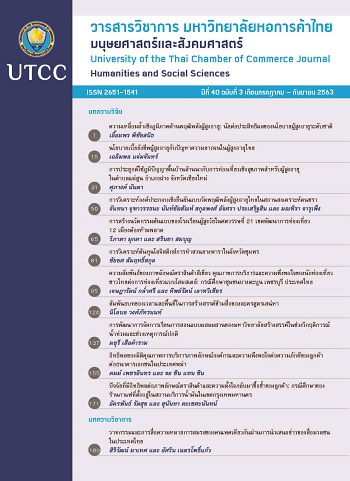นโยบายเบี้ยยังชีพผู้สูงอายุกับปัญหาความยากจนในผู้สูงอายุไทย
Main Article Content
บทคัดย่อ
ตั้งแต่ปี 2552 ประเทศไทยมีระบบการจ่ายเบี้ยยังชีพแบบถ้วนหน้าให้กับผู้สูงอายุทุกคนที่ไม่ได้รับบํานาญข้าราชการ หรือสิทธิประโยชน์ กรณีชราภาพ จากระบบประกันสังคม ในอัตราต่อเดือนแบบขั้นบันไดตามช่วงอายุที่เพิ่มขึ้น การศึกษานี้ มีวัตถุประสงค์เพื่อเปรียบเทียบผลกระทบของการปรับอัตราการจ่ายเบี้ยยังชีพผู้สูงอายุในประเทศไทยภายใต้ 2 ทางเลือก ที่มีต่อการบรรเทาความยากจนในผู้สูงอายุ ทางเลือกที่ 1 เป็นการปรับเปลี่ยนอัตราเบี้ยยังชีพเป็น 1,000 บาท ให้กับผู้สูงอายุทุกคนเท่ากันในทุกช่วงอายุ ทางเลือกที่ 2 เป็นการปรับเพิ่มอัตราเบี้ยยังชีพในปริมาณที่เท่ากันบนฐานอัตราเบี้ยยังชีพแบบขั้นบันไดตามช่วงอายุของผู้สูงอายุในปัจจุบัน โดยกำหนดให้ทั้งสองทางเลือกมีภาระค่าใช้จ่ายภาครัฐที่จะเพิ่มขึ้นเท่ากัน การวิเคราะห์ใช้ข้อมูลการสำรวจภาวะเศรษฐกิจและสังคมของครัวเรือน พ.ศ. 2560 เป็นฐาน ร่วมกับข้อมูลระดับรายจ่ายเพื่อการบริโภคของประชากรไทยรายอายุ จากโครงการวิจัยการโอนทางเศรษฐกิจระหว่างรุ่นประชากรฯ ผลการศึกษาพบว่า รายจ่ายเพื่อการบริโภคของผู้สูงอายุไทยมีแนวโน้มลดลงตามช่วงอายุที่เพิ่มขึ้น ขณะที่ความเสี่ยงและความเปราะบางต่อความยากจนมีแนวโน้มเพิ่มขึ้น การพิจารณาปรับเพิ่มอัตราเบี้ยยังชีพผู้สูงอายุภายใต้ทางเลือกที่ 2 โดยคงอัตราแบบขั้นบันไดตามช่วงอายุที่เพิ่มขึ้นของผู้สูงอายุ สามารถเพิ่มระดับการบริโภคของผู้สูงอายุทุกกลุ่ม ขณะเดียวกันมีความเป็นธรรมในการปกป้องช่วยเหลือผู้สูงอายุจากความยากจน โดยเฉพาะต่อกลุ่มผู้สูงอายุวัยกลางและวัยปลายได้ดีกว่าทางเลือกที่ 1 ซึ่งปรับเปลี่ยนเบี้ยยังชีพเป็นอัตราต่อเดือนที่เท่ากันในทุกช่วงอายุ
Article Details
ลิขสิทธิ์ของบทความ
ผลงานที่ได้รับการตีพิมพ์ถือเป็นลิขสิทธิ์ของมหาวิทยาลัยหอการค้าไทย ห้ามมิให้นำเนื้อหา ทัศนะ หรือข้อคิดเห็นใด ๆ ของผลงานไปทำซ้ำ ดัดแปลง หรือเผยแพร่ ไม่ว่าทั้งหมดหรือบางส่วนโดยไม่ได้รับอนุญาตเป็นลายลักษณ์อักษรจากมหาวิทยาลัยหอการค้าไทยก่อน
เอกสารอ้างอิง
กระทรวงมหาดไทย. (2552). ระเบียบกระทรวงมหาดไทย ว่าด้วยหลักเกณฑ์การจ่ายเงินเบี้ยยังชีพผู้สูงอายุขององค์กรปกครองส่วนท้องถิ่น พ.ศ. 2552. กรุงเทพฯ: ผู้แต่ง.
ข่าวดี! ครม.ไฟเขียวปรับเบี้ยคนพิการ 1,000 บาท. (2563, 28 มกราคม). ข่าวไทยพีบีเอส. สืบค้นจาก https://news.thaipbs.or.th/content/288403
“จุติ”จ่อขอเพิ่มงบ ดันเบี้ยยังชีพผู้สูงอายุ 1,000 บ. เป็นจริง. (2562, 22 กรกฎาคม). ฐานเศรษฐกิจ. สืบค้นจาก https://www.thansettakij.com/content/405598
เฉลิมพล แจ่มจันทร์, สุภรต์ จรัสสิทธิ์, และ ณัฐณิชา ลอยฟ้า. (2562). การโอนทางเศรษฐกิจระหว่างรุ่นประชากรในสังคมสูงอายุไทย. นครปฐม: มหาวิทยาลัยมหิดล, สถาบันวิจัยประชากรและสังคม.
ชงเพิ่มเบี้ยยังชีพผู้สูงอายุ เป็นเดือนละ 1,000 บาท. (2561, 19 พฤศจิกายน). ข่าวไทยพีบีเอส. สืบค้นจาก https://news.thaipbs.or.th/content/275781
ธนาคารโลก. (2555). การลดปัญหาความยากจนของผู้สูงอายุในประเทศไทย: บทบาทของโครงการบำนาญและการช่วยเหลือทางสังคม. กรุงเทพฯ: ผู้แต่ง.
เบี้ยยังชีพผู้สูงอายุ อุ่นใจได้ทุกเดือน. (2563, 18 มีนาคม). สำนักข่าวไทย. สืบค้นจาก https://www.mcot.net/viewtna/5e72155ce3f8e40af9426e05
รัชพันธ์ เชยจิตร. (2555). ความเหลื่อมล้ำของรายได้กับ หลักประกันรายได้สำหรับผู้สูงอายุไทย. วารสารเศรษฐศาสตร์และนโยบายสาธารณะ, 3(5), 69-86.
วิชุดา สาธิตพร, สติธร ธนานิธิโชติ, ธนพันธ์ ไล่ประกอบทรัพย์, และ สุนิสา ช่อแก้ว. (2560). การสร้างความเป็นธรรมทางสังคมผ่านนโยบายสวัสดิการสังคม: กรณีศึกษาการเข้าถึงและได้รับประโยชน์. สำนักงานผู้ตรวจการแผ่นดิน, 10 (1), 50-79.
ส่องนโยบายขายฝัน 6 พรรคการเมืองแห่เพิ่มเงิน “เบี้ยคนชรา” ทำได้จริงหรือ. (2562, 25 กุมภาพันธ์). ไทยรัฐออนไลน์. สืบค้นจาก https://www.thairath.co.th/news/politic/1502596
สำนักเลขาธิการคณะรัฐมนตรี. (2554). มติคณะรัฐมนตรีเรื่องการกำหนดอัตราเบี้ยยังชีพผู้สูงอายุ สืบค้นเมื่อ 19 ธันวาคม 2562, จาก http://www.cabinet.soc.go.th/soc/Program2-3.jsp?top_serl=99228836
Ando, A., & Modigliani, F. (1963). The Life cycle hypothesis of saving: Aggregate implications and tests. American Economic Review, 53(1), 55-84.
Chamchan, C. (2018). Preparedness for old-age income security and support of the Thai pre-elderly. In T. R.Klassen, M. Higo, N. S.Dhirathiti, & T. W. Devasahayam (Eds.), Ageing in Asia-Pacific interdisciplinary and comparative perspectives (pp. 192-212). New York, NY: Routledge.
Emery, J. H., & Matheson, J. A. (2012). Should income transfers be targeted or universal? Insights from public pension influences on elderly mortality in Canada, 1921–1966. Canadian Journal of Economics, 45(1), 247-269.
Hagemejer, K., & Schmitt, V. (2013). How to provide basic income security to all elderly people? Brasilia, Brazil: International Policy Centre for Inclusive Growth.
Haughton, J., & Khandker, S. R. (2009). Handbook on poverty and inequality. Washington DC: The World Bank.
Holzman, R., & Hinz, R. (2005). Old-age income support in the 21st century : An international perspective on pension systems and reform. Washington, DC: The World Bank.
International Labour Office. (2017). World social protection report 2017–19: Universal social protection to achieve the sustainable development goal. Geneva, Switzerland: Author.
International Labour Office, Social Protection Department. (2016). Improving the lives of older persons through Universal Social Pensions (Thailand). Geneva, Switzerland: Author.
Knox-Vydmanov, C. (2011). The price of income security in older age: Cost of a universal pension in 50 low- and middleincome. London, England: HelpAge International.
Modigliani, F., & Ando, A. (1957). Test of the life cycle hypothesis of saving. Oxford Bulletin of Economics and Statistics, 19, 99-124.
Organisation for Economic Co-operation and Development. (2019). Pensions at a glance 2019: OECD and G20 indicators. Paris, France: Author.
Suwanrada, W., Sukontamarn, P., & Bangkaew, B. (2018). Who supports intergenerational redistribution policy? Evidence from old age allowance system in Thailand. The Journal of the Economics of Ageing, 12, 24-34.
Temple, J. B., Rice, J. M., & McDonald, P. F. (2017). Economics of ageing feature ageing and the economic life cycle: The national transfer accounts approach. Australasian Journal on Ageing, 36(4), 271–278.
United Nations. (2013). National transfer accounts manual: Measuring and analysing the
generational economy. New York, NY: Author.


